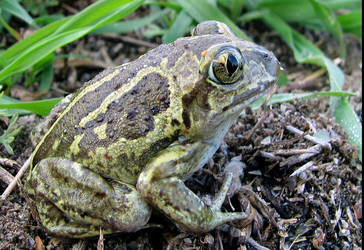Pelobatidae
Spadefoot Toads
David Cannatella- Macropelobates
 (incertae sedis)
(incertae sedis) - Pelobates
- Pelobates cultripes
- Pelobates fuscus
- Pelobates syriacus
- Pelobates varaldii
Introduction
Pelobatidae are the European and American Spadefoot Toads. The content of the family as used here is more restricted than many others use it. The Asian megophryines and pelodytines were recognized as full families, Megophryidae and Pelodytidae, by Cannatella (1985).
Living pelobatids are rotund with short limbs and large eyes with vertical pupils. However, it is possible (but not yet demonstrated) that the morphology of the living forms is convergent, because some fossil pelobatids of the genus Eopelobates are rather gracile, lightly-built animals. In order to burrow, spadefoot toads use the spade, a bony element of the hindfoot capped with a keratinous cover. They do so rear-first into the ground (most burrowing frogs do so rear-first, only a very few such as Hemisus, enter the ground head-first).
The North American species have been placed in either one genus (Scaphiopus) or two (Spea, for the smaller species). Each group is monophyletic, so the division is somewhat arbitrary. However, the two groups are different in morphology and ecology, so recognition of two genera emphasizes the distinctiveness of each.
Pelobates are also well known as fossils from as far back as the Eocene and extend to the present. Scaphiopus is known from the early Oligocene. Macropelobates is from the Middle Oligocene.
Geographic Distribution
The distribution of living members of the family Pelobatidae is indicated in red.


Discussion of Phylogenetic Relationships
As generally used, Pelobatidae (for megophryines and pelobatines) is not demonstrably monophyletic, because of the ambiguous relationships of Pelodytes. Cannatella (1985) removed megophryids from Pelobatidae. The name Pelobatidae was defined by Ford and Cannatella (1993) as the node that is the most recent common ancestor of living Pelobates, Scaphiopus, and Spea, and all of its descendants. Each of the aforementioned taxa is monophyletic (Cannatella, 1985). Synapomorphies of Pelobatidae include fusion of the joint between the sacrum and coccyx, exostosed frontoparietals, and the presence of a metatarsal spade supported by a well-ossified prehallux.
The definition of this name differs from that used by most other workers, in that megophryines are excluded from Pelobatidae. The extinct subfamily †Eopelobatinae* (Spinar, 1972) is not included in the definition because of uncertainty concerning the relationships and monophyly of that taxon. Some †Eopelobates appear to be more closely related to the living Pelobates than are Scaphiopus and Spea, so the subfamily may be an artifact of placing a group of extinct forms into a taxon. It is a metataxon of uncertain placement, either within Pelobatoidea, or the sister taxon of Pelobatoidea.
References
Click here for general list of references
Title Illustrations

| Scientific Name | Pelobates syriacus |
|---|---|
| Location | Romania |
| Specimen Condition | Live Specimen |
| Identified By | Horia Bogdan |
| Image Use |
 This media file is licensed under the Creative Commons Attribution-NonCommercial License - Version 2.0. This media file is licensed under the Creative Commons Attribution-NonCommercial License - Version 2.0.
|
| Copyright |
© Horia Bogdan

|
About This Page
If you are interested in authoring or co-authoring the page for this taxon, or some part of it (even a species), contact David Cannatella.
David Cannatella

University of Texas, Austin, Texas, USA
Correspondence regarding this page should be directed to David Cannatella at
Page copyright © 1995 David Cannatella
 Page: Tree of Life
Pelobatidae. Spadefoot Toads.
Authored by
David Cannatella.
The TEXT of this page is licensed under the
Creative Commons Attribution License - Version 3.0. Note that images and other media
featured on this page are each governed by their own license, and they may or may not be available
for reuse. Click on an image or a media link to access the media data window, which provides the
relevant licensing information. For the general terms and conditions of ToL material reuse and
redistribution, please see the Tree of Life Copyright
Policies.
Page: Tree of Life
Pelobatidae. Spadefoot Toads.
Authored by
David Cannatella.
The TEXT of this page is licensed under the
Creative Commons Attribution License - Version 3.0. Note that images and other media
featured on this page are each governed by their own license, and they may or may not be available
for reuse. Click on an image or a media link to access the media data window, which provides the
relevant licensing information. For the general terms and conditions of ToL material reuse and
redistribution, please see the Tree of Life Copyright
Policies.
- Content changed 11 January 2008
Citing this page:
Cannatella, David. 2008. Pelobatidae. Spadefoot Toads. Version 11 January 2008 (under construction). http://tolweb.org/Pelobatidae/16979/2008.01.11 in The Tree of Life Web Project, http://tolweb.org/








 Go to quick links
Go to quick search
Go to navigation for this section of the ToL site
Go to detailed links for the ToL site
Go to quick links
Go to quick search
Go to navigation for this section of the ToL site
Go to detailed links for the ToL site